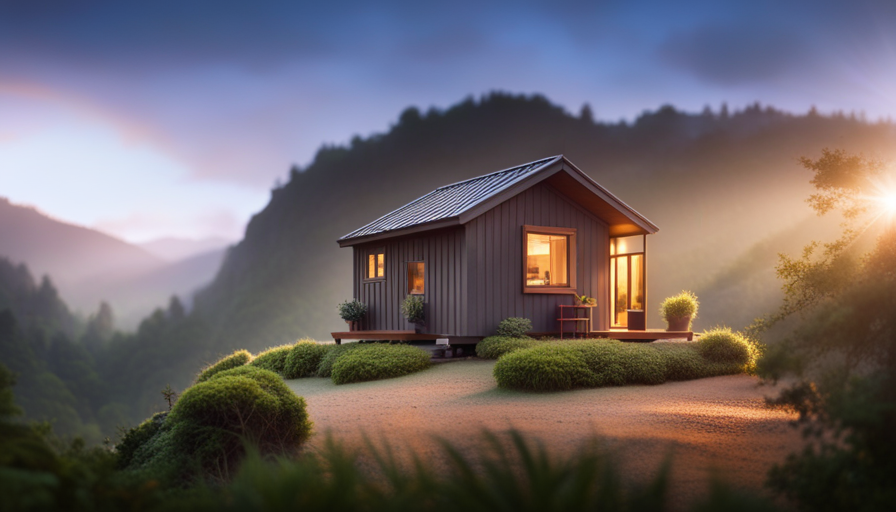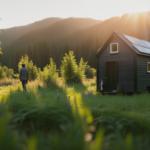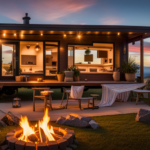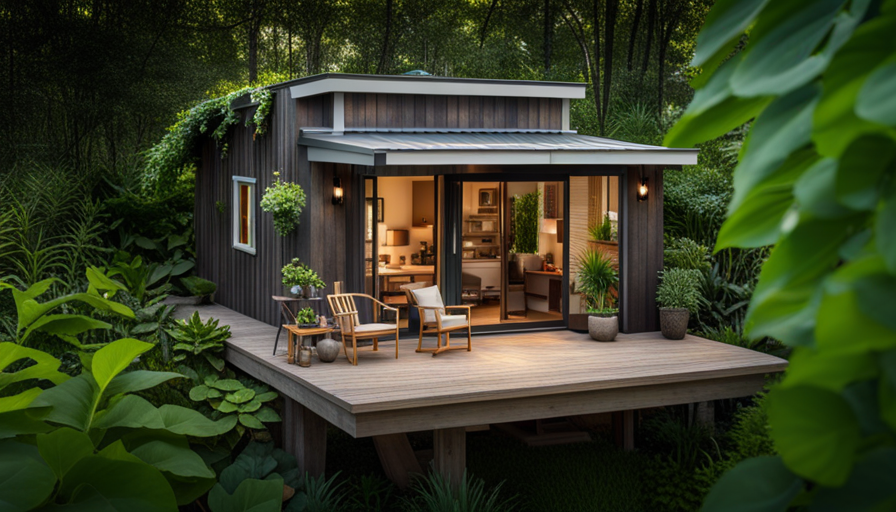Imagine a world in which traditional living space limitations are a thing of the past, and you are free to live in a home that truly represents your uniqueness. Picture a way of life where adopting minimalism, reducing your impact on the environment, and embracing a simpler, more eco-friendly existence is the standard. This is what the tiny house movement is all about.
These pint-sized dwellings have captured the hearts and imaginations of people across the globe, offering a refreshing alternative to the status quo. But before you dive headfirst into the tiny house movement, it’s important to understand the legalities that come with it. Zoning laws and regulations dictate the size and placement of structures, which begs the question: how big can a tiny house be without being zoned?
In this article, we will explore the ins and outs of zoning laws, alternative building methods, and off-grid living options, empowering you to navigate the world of tiny house living with confidence and clarity. Let’s embark on this exciting journey together.
Key Takeaways
- Understanding setback requirements is crucial for determining the size of a tiny house without zoning issues.
- Researching tiny house zoning exemptions can help identify exceptions to general zoning laws.
- Maximizing space in a tiny house is essential for creating a functional living environment.
- Efficient layouts, multi-functional furniture, and clever storage solutions are key elements in maximizing space in a tiny house.
Understanding Zoning Laws and Regulations
Zoning laws and regulations dictate the maximum size a tiny house can be without requiring specific zoning. Understanding setback requirements is crucial when determining the size of a tiny house. Setback requirements refer to the minimum distance a structure must be set back from property lines or other structures.
By researching tiny house zoning exemptions, one can identify any exceptions to the general zoning laws that may allow for a larger tiny house. This involves looking into specific regulations and requirements that pertain to tiny houses, such as minimum square footage or maximum height restrictions. By familiarizing oneself with these regulations, one can ensure compliance and avoid potential legal issues.
Maximizing space in a tiny house is essential for creating a functional and comfortable living environment.
Maximizing Space in a Tiny House
When it comes to maximizing space in a tiny house, there are three key points to consider:
- Designing efficient layouts
- Utilizing multi-functional furniture
- Incorporating clever storage solutions
By carefully planning the layout, I can ensure that every inch of my tiny house is utilized effectively. Additionally, choosing furniture that serves multiple purposes allows me to make the most of limited space, while clever storage solutions help keep everything organized and out of sight.
Design Efficient Layouts
Creating an efficient layout allows for maximum utilization of space in a tiny house, resulting in a visually pleasing and functional living area.
Here are four key elements to consider when designing space efficient interiors and optimizing natural light:
-
Open floor plan: By removing unnecessary walls, you can create a sense of spaciousness and flow throughout the tiny house. This allows for flexibility in furniture placement and enhances the overall functionality of the space.
-
Utilize vertical space: Make use of tall ceilings by incorporating loft areas for sleeping or storage. Installing high shelves and cabinets can also maximize storage capacity without taking up valuable floor space.
-
Multipurpose rooms: Design rooms with multiple functions in mind. For example, a dining area that can double as a workspace or a sofa that can convert into a bed for guests. This maximizes the functionality of each room and eliminates the need for separate spaces.
-
Strategic placement of windows: Incorporate large windows and skylights to bring in natural light and create the illusion of a larger space. This not only makes the tiny house feel more open, but also reduces the need for artificial lighting during the day.
By implementing these design strategies, you can create an efficient layout that maximizes space and optimizes natural light in your tiny house.
This seamless transition into the subsequent section about utilizing multi-functional furniture allows for even more creative use of space.
Utilize Multi-Functional Furniture
To make the most of your limited space, try incorporating multi-functional furniture into your tiny house design. Multi-functional furniture offers a wide range of benefits in a small living space. Not only does it save space, but it also adds versatility and functionality to your home.
There are various space-saving furniture options available that can serve multiple purposes. For example, a sofa that can transform into a bed or a coffee table that doubles as a dining table. These furniture pieces can help maximize your living area without compromising on comfort or style.
By utilizing multi-functional furniture, you can create a flexible and efficient layout that meets all your needs in a compact space. As we delve into the next section about clever storage solutions, you’ll see how these furniture choices seamlessly transition into creating a well-organized and clutter-free environment.
Incorporate Clever Storage Solutions
By incorporating clever storage solutions, you can revolutionize the way you organize and store your belongings in your small living space and achieve a clutter-free oasis that will make your jaw drop.
Clever storage hacks and space-saving solutions are essential in making the most of limited square footage. Utilizing under-bed storage containers, hanging shoe organizers, and wall-mounted shelves can help maximize vertical space and keep your belongings easily accessible.
Opting for furniture with built-in storage compartments, such as ottomans or coffee tables with hidden compartments, can also provide additional storage options. Additionally, utilizing the space behind doors with over-the-door organizers or installing shelves above doorways can help create additional storage areas.
By incorporating these clever storage solutions, you can create a functional and organized living space that maximizes every inch. Transitioning into exploring alternative building methods, let’s discover innovative ways to create more spacious tiny homes.
Exploring Alternative Building Methods
Imagine the freedom of exploring alternative building methods for your tiny house, finding unique ways to maximize space and create a home that truly reflects your personality.
When it comes to alternative construction techniques, there are a plethora of options to consider. Firstly, you can explore the concept of using repurposed materials, such as reclaimed wood or recycled shipping containers, to construct your tiny house. This not only adds a touch of creativity to your design but also promotes sustainability by reducing waste.
Secondly, you can incorporate modular building systems, which involve using prefabricated components that can be easily assembled on-site. This approach allows for efficient construction and easy customization.
Lastly, consider using innovative sustainable building materials, such as straw bales or rammed earth, which are not only eco-friendly but also offer excellent insulation properties. By exploring these alternative methods, you can create a unique and environmentally conscious tiny house that stands out from the rest.
Transitioning into the subsequent section about navigating building codes and permits, it’s important to understand the regulations and requirements in order to ensure a smooth and successful building process.
Navigating Building Codes and Permits
When it comes to navigating building codes and permits, there are three key points that I want to discuss.
First, it’s crucial to obtain all necessary building permits before starting any construction. This ensures that your project is legal and meets all safety requirements.
Second, hiring a licensed contractor is essential to ensure that the construction is done by professionals who are knowledgeable about building codes and can guarantee quality work.
Lastly, it’s important to ensure compliance with building codes throughout the entire construction process to avoid any penalties or legal issues.
Obtain Necessary Building Permits
To build a tiny house without zoning restrictions, it’s crucial to secure the necessary building permits. Obtaining these permits requires navigating local regulations and understanding the specific requirements of your jurisdiction. This process can be complex and time-consuming, but it is essential to ensure that your tiny house is legal and meets all safety standards.
To help you visualize the steps involved in obtaining building permits, I have created a table below:
| Steps to Obtain Building Permits | ||||
|---|---|---|---|---|
| Research local regulations | Determine permit requirements | Prepare necessary documents | Submit permit application | Wait for approval and inspections |
By following these steps, you can ensure that you have all the necessary permits before starting construction on your tiny house. Once you have obtained the permits, the next step is to hire a licensed contractor who can help bring your vision to life.
Transitioning into the next section about hiring a licensed contractor, it’s important to find someone who is experienced in building tiny houses and familiar with local building codes.
Hire a Licensed Contractor
Once you’ve obtained the necessary building permits, it’s time to find a licensed contractor who can turn your dream of a legal and safe tiny home into a reality. Hiring a licensed contractor is crucial as they have the expertise and knowledge to navigate the complexities of construction and ensure compliance with building codes.
When searching for a contractor, it’s important to choose someone who specializes in tiny house construction and has experience in designing efficient layouts. They’ll be able to maximize the use of space and create a functional living area within the confines of a small footprint.
Additionally, a licensed contractor will have the necessary insurance and certifications, providing you with peace of mind throughout the building process. By hiring a qualified contractor, you can ensure that your tiny house is built to code and meets all safety requirements, setting the stage for a successful and hassle-free project.
Ensure Compliance with Building Codes
Make sure you’re in compliance with building codes by following these important regulations.
When building a tiny house, it’s crucial to adhere to local building codes to ensure the safety and structural integrity of your home. Building codes vary by location and may dictate requirements for things like foundation, electrical systems, plumbing, and overall building design.
To maximize efficiency and make the most of your limited space, consider incorporating space-saving techniques such as built-in storage, multi-functional furniture, and innovative design solutions. By carefully planning and implementing these strategies, you can create a tiny house that is both functional and aesthetically pleasing.
As you navigate the process of building your tiny home, it’s also worth considering joining tiny house communities, where you can learn from others, share resources, and find support in your tiny living journey.
Joining Tiny House Communities
When it comes to joining tiny house communities, there are several key points to consider.
Firstly, finding supportive tiny house communities can provide a wealth of knowledge and resources.
Attending tiny house workshops and events allows for hands-on learning and networking opportunities.
Lastly, connecting with other tiny house enthusiasts can offer valuable insights and a sense of community.
Overall, these three aspects are essential for navigating the world of tiny house living and finding support along the way.
Find Supportive Tiny House Communities
Discover thriving communities that embrace the tiny house movement and provide the support you need to create your dream home. These supportive resources are essential for anyone considering the tiny house lifestyle.
One of the main challenges people face when building a tiny house is financing. However, many supportive tiny house communities offer assistance and guidance on securing tiny house financing. They can connect you with lenders who specialize in tiny house loans or help you explore alternative financing options.
These communities also provide a wealth of knowledge and experience, allowing you to learn from others who have already gone through the process of building and living in a tiny house. By joining these communities, you can tap into a network of like-minded individuals who can offer advice, share resources, and inspire you on your tiny house journey.
Transitioning into the subsequent section, attending tiny house workshops and events is another excellent way to gain valuable insights and expand your knowledge base.
Attend Tiny House Workshops and Events
Get ready to immerse yourself in the world of tiny houses by attending workshops and events that will expand your knowledge and connect you with a community of like-minded individuals. These workshops and events provide an excellent opportunity to learn about the latest trends in tiny house design and sustainable living. By participating in these activities, you can gain valuable insights into how to maximize space, incorporate eco-friendly features, and create a functional and beautiful tiny home.
To give you a taste of what you can expect from these workshops and events, take a look at the table below:
| Workshop/Event | Description |
|---|---|
| Tiny House Design Workshop | Learn from experts about the principles of good design and how to adapt them to the unique challenges of tiny house living. |
| Sustainable Living Symposium | Explore innovative ways to incorporate sustainable practices into your tiny house, from renewable energy sources to water conservation techniques. |
| Tiny House Festival | Connect with other tiny house enthusiasts, tour a variety of tiny homes, and attend informative workshops and presentations. |
| DIY Tiny House Building Workshop | Gain hands-on experience and learn practical skills for building your own tiny house, from foundation to finishing touches. |
By attending these workshops and events, you can deepen your understanding of tiny house design and sustainable living, and connect with a vibrant community of individuals who share your passion. Transitioning into the next section, let’s explore how you can further connect with fellow tiny house enthusiasts.
Connect with Tiny House Enthusiasts
To truly dive into the world of tiny houses, you can connect with a community of like-minded individuals who share your passion for compact and sustainable living. By engaging with other tiny house enthusiasts, you’ll have the opportunity to learn from their experiences, share design ideas, and gain valuable insights into the tiny house movement.
Here are three ways to connect with this community:
-
Join online forums and social media groups dedicated to tiny houses. These platforms provide a space for enthusiasts to ask questions, share resources, and connect with others who’re also interested in tiny living.
-
Attend tiny house workshops and events. These gatherings often feature experts in the field who can provide guidance on design, construction, and zoning regulations. They also offer opportunities to network with fellow enthusiasts and exchange ideas.
-
Consider joining a local tiny house association or meetup group. These organizations often host regular meetings, where you can connect with others in your area who’re passionate about tiny living.
By connecting with like-minded individuals, you can gain valuable knowledge and inspiration for your own tiny house journey. Transitioning into considering off-grid living options, it’s important to explore sustainable energy sources and self-sufficiency strategies.
Considering Off-Grid Living Options
When considering off-grid living options, it’s important to explore solar power and alternative energy sources to provide electricity for your tiny house.
Implementing water conservation methods is also crucial to ensure a sustainable water supply, especially in remote locations.
Additionally, it’s essential to learn about composting toilets and greywater systems as environmentally friendly alternatives to traditional sewage systems.
Explore Solar Power and Alternative Energy Sources
Imagine how liberating it would be to power your tiny house with solar energy, freeing yourself from the constraints of traditional energy sources. By incorporating solar panel installation into your tiny house design, you can harness the power of the sun to meet your energy needs.
Solar panels are a sustainable and eco-friendly solution, allowing you to reduce your carbon footprint and minimize your reliance on fossil fuels. Additionally, by using eco-friendly building materials in the construction of your tiny house, you can further enhance its sustainability. Consider using materials such as reclaimed wood, bamboo, or recycled metal. These materials not only contribute to a more eco-conscious lifestyle but also add a unique aesthetic to your tiny house.
Implementing water conservation methods is another crucial aspect of off-grid living, which we will explore in the subsequent section.
Implement Water Conservation Methods
By incorporating water-saving techniques into my off-grid lifestyle, I can create a sustainable oasis that conserves this precious resource. One effective method is water collection, which involves capturing rainwater and using it for various purposes. This not only reduces dependency on municipal water supplies but also helps conserve water in times of drought. Rainwater harvesting systems can be as simple as a collection barrel connected to a downspout, or more elaborate with underground tanks and filtration systems. Another technique to consider is greywater recycling, which involves reusing water from sinks, showers, and laundry for irrigation purposes. By implementing these water conservation methods, I can minimize my environmental impact and create a self-sufficient living space. In the subsequent section, I will explore composting toilets and greywater systems to further enhance my off-grid lifestyle.
Learn about Composting Toilets and Greywater Systems
Implementing composting toilets and greywater systems into my off-grid lifestyle allows for the efficient and sustainable management of waste and water resources.
Composting toilets are a great alternative to traditional flushing toilets as they don’t require water for operation and can significantly reduce water usage. They also have the added benefit of producing nutrient-rich compost that can be used in gardening or landscaping.
Greywater systems, on the other hand, involve collecting and treating water from sources such as sinks, showers, and washing machines. This treated water can then be reused for purposes like irrigation or flushing toilets.
By implementing these systems, I’m able to minimize my environmental impact and reduce my reliance on external resources.
Moving forward, staying informed and up to date with the latest advancements in composting toilets and greywater systems will ensure that I continue to maximize their benefits and make the most of my off-grid lifestyle.
Staying Informed and Up to Date
Staying informed and keeping up to date is crucial if you want to avoid any legal pitfalls when it comes to building a tiny house that falls outside zoning restrictions. One of the best ways to stay connected and informed is by joining online communities and forums dedicated to tiny house living. These platforms provide a wealth of information, from updates on changes in zoning regulations to tips on navigating legal loopholes.
Additionally, attending workshops and conferences focused on tiny house living can also provide valuable insights and connections. It’s important to remember that zoning regulations can vary greatly from one area to another, so staying informed about the specific rules and regulations in your intended location is essential.
By staying connected and staying informed, you can ensure that your tiny house project remains legally compliant and avoid any unnecessary headaches down the road.
Frequently Asked Questions
Are there any specific restrictions on the design or appearance of a tiny house?
There are specific design restrictions and appearance guidelines for tiny houses. These guidelines vary depending on the location and local zoning regulations. Some common restrictions include the maximum height, width, and length of the house, as well as requirements for materials and architectural style. Additionally, there may be guidelines regarding the placement of windows, doors, and exterior finishes. It’s important to research and comply with these regulations to ensure your tiny house meets the necessary standards.
Can I legally park my tiny house on someone else’s property?
Legally parking a tiny house on someone else’s property depends on the parking regulations in your area and obtaining the property owner’s consent. Before doing so, it’s important to research local zoning laws, as they may have restrictions on residential parking. Additionally, you should consider the specific requirements and permits needed for utilities and waste disposal.
Always consult with local authorities and seek legal advice to ensure compliance with regulations and avoid potential issues.
Are there any tax benefits or incentives for living in a tiny house?
There are indeed tax benefits and financial incentives for living in a tiny house. By downsizing and living in a smaller space, you can potentially save on property taxes, utility bills, and maintenance costs.
Additionally, some states offer specific tax credits or deductions for tiny house owners, such as renewable energy incentives or affordable housing incentives. It’s important to research the specific regulations and incentives in your area to maximize your savings.
Can I rent out my tiny house as a vacation rental or Airbnb?
Sure, I’d love to answer that! Renting out tiny houses as vacation rentals or on Airbnb can be a fantastic idea. However, it’s important to be aware of the regulations in your area.
Many cities and towns have specific rules and permits for vacation rentals, so it’s crucial to do your research and ensure you’re following all the necessary guidelines. This will help you avoid any legal issues and make the most of your tiny house rental venture.
Are there any limitations on the types of utilities available for a tiny house, such as water and electricity?
There are certain limitations on the types of utilities available for tiny houses, such as water and electricity. Regulations on tiny house utilities may vary depending on the location and local building codes. These regulations may include restrictions on the size and capacity of water and electrical systems.
It’s important to research and comply with these regulations to ensure that your tiny house meets all necessary requirements for water and electricity usage.
Conclusion
In conclusion, the journey to discovering the limits of a tiny house without zoning restrictions has been an eye-opening experience. By understanding zoning laws and maximizing space, we can create a home that defies the boundaries set by society. Exploring alternative building methods and navigating building codes are also important in this process. Additionally, joining tiny house communities and considering off-grid living options can further expand our possibilities. It’s essential to stay informed and up to date with the ever-changing regulations to ensure our tiny house dreams become a reality. So, let’s break free from the constraints and build a tiny house that knows no limits.
Hi, I’m Emma. I’m the Editor in Chief of Tiny House 43, a blog all about tiny houses. While tree houses are often associated with childhood, they can be the perfect adult retreat. They offer a cozy space to relax and unwind, surrounded by nature. And since they’re typically built on stilts or raised platforms, they offer stunning views that traditional homes simply can’t match. If you’re looking for a unique and romantic getaway, a tree house tiny house might just be the perfect option.
















